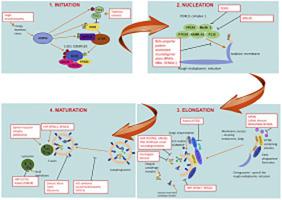当前位置:
X-MOL 学术
›
J. Mol. Biol.
›
论文详情
Our official English website, www.x-mol.net, welcomes your
feedback! (Note: you will need to create a separate account there.)
Autophagy in Rare (NonLysosomal) Neurodegenerative Diseases.
Journal of Molecular Biology ( IF 4.7 ) Pub Date : 2020-02-19 , DOI: 10.1016/j.jmb.2020.02.012 Malgorzata Zatyka 1 , Sovan Sarkar 1 , Timothy Barrett 2
Journal of Molecular Biology ( IF 4.7 ) Pub Date : 2020-02-19 , DOI: 10.1016/j.jmb.2020.02.012 Malgorzata Zatyka 1 , Sovan Sarkar 1 , Timothy Barrett 2
Affiliation

|
Neurodegenerative diseases (NDDs) comprise conditions with impaired neuronal function and loss and may be associated with a build-up of aggregated proteins with altered physicochemical properties (misfolded proteins). There are many disorders, and causes include gene mutations, infections, or exposure to toxins. The autophagy pathway is involved in the removal of unwanted proteins and organelles through lysosomes. While lysosomal storage disorders have been described for many years, it is now recognised that perturbations of the autophagy pathway itself can also lead to neurodegenerative disease. These include monogenic disorders of key proteins involved in the autophagy pathway, and disorders within pathways that critically control autophagy through monitoring of the supply of nutrients (mTORC1 pathway) or of energy supply in cells (AMPK pathway). This review focuses on childhood-onset neurodegenerative disorders with perturbed autophagy, due to defects in the autophagy pathway, or in upstream signalling via mTORC1 and AMPK. The review first provides a short description of autophagy, as related to neurons. It then examines the extended role of autophagy in neuronal function, plasticity, and memory. There follows a description of each step of the autophagy pathway in greater detail, illustrated with examples of diseases grouped by the stage of their perturbation of the pathway. Each disease is accompanied by a short clinical description, to illustrate the diversity but also the overlap of symptoms caused by perturbation of key proteins necessary for the proper functioning of autophagy. Finally, there is a consideration of current challenges that need addressing for future therapeutic advances.
中文翻译:

罕见(非溶酶体)神经退行性疾病中的自噬。
神经退行性疾病 (NDD) 包括神经元功能受损和丧失的疾病,并且可能与具有改变的物理化学性质的聚集蛋白(错误折叠蛋白)的积累有关。有许多疾病,原因包括基因突变、感染或接触毒素。自噬途径涉及通过溶酶体去除不需要的蛋白质和细胞器。虽然溶酶体贮积症已被描述多年,但现在人们认识到自噬途径本身的扰动也可能导致神经退行性疾病。这些包括参与自噬途径的关键蛋白的单基因疾病,以及通过监测营养供应(mTORC1途径)或细胞能量供应(AMPK途径)来严格控制自噬的途径内的疾病。本综述重点关注由于自噬途径缺陷或通过 mTORC1 和 AMPK 的上游信号传导而导致自噬受到干扰的儿童期发病神经退行性疾病。该评论首先提供了与神经元相关的自噬的简短描述。然后,它检查了自噬在神经元功能、可塑性和记忆中的扩展作用。随后更详细地描述了自噬途径的每个步骤,并以疾病的例子进行了说明,这些疾病按其对途径的扰动阶段进行了分组。每种疾病都附有简短的临床描述,以说明自噬正常发挥作用所必需的关键蛋白质的扰动引起的症状的多样性和重叠。最后,
更新日期:2020-02-19
中文翻译:

罕见(非溶酶体)神经退行性疾病中的自噬。
神经退行性疾病 (NDD) 包括神经元功能受损和丧失的疾病,并且可能与具有改变的物理化学性质的聚集蛋白(错误折叠蛋白)的积累有关。有许多疾病,原因包括基因突变、感染或接触毒素。自噬途径涉及通过溶酶体去除不需要的蛋白质和细胞器。虽然溶酶体贮积症已被描述多年,但现在人们认识到自噬途径本身的扰动也可能导致神经退行性疾病。这些包括参与自噬途径的关键蛋白的单基因疾病,以及通过监测营养供应(mTORC1途径)或细胞能量供应(AMPK途径)来严格控制自噬的途径内的疾病。本综述重点关注由于自噬途径缺陷或通过 mTORC1 和 AMPK 的上游信号传导而导致自噬受到干扰的儿童期发病神经退行性疾病。该评论首先提供了与神经元相关的自噬的简短描述。然后,它检查了自噬在神经元功能、可塑性和记忆中的扩展作用。随后更详细地描述了自噬途径的每个步骤,并以疾病的例子进行了说明,这些疾病按其对途径的扰动阶段进行了分组。每种疾病都附有简短的临床描述,以说明自噬正常发挥作用所必需的关键蛋白质的扰动引起的症状的多样性和重叠。最后,


















































 京公网安备 11010802027423号
京公网安备 11010802027423号